
Description :
The main objective of the Junior Researcher Webinar is to provide an opportunity for PhD students and Postdocs to present their research within the fields covered by the GdR RESANET. This is an exclusive occasion for them to showcase their work, foster discussions and connect with potential collaborators.
Webinars are hosted online on Mondays afternoon, once or twice a month, alternating with the GdR RESANET Scientific Colloquium webinars. They consist of 40-minutes presentations tailored to a diverse audience, followed by an interactive question and answer session.
Willing to give a talk ?
Please follow this link :
Submit an abstract
Organizers
L. Dienis (Ganil – Caen) – laurie.dienis@ganil.fr,
Q. Fable (L2IT-IN2P3 Toulouse) – quentin.fable@l2it.in2p3.fr,
L. Heitz (IRFU-CEA Saclay, IJCLab – IN2P3 Orsay) – louis.heitz@ijclab.in2p3.fr
T. Zanatta-Martinez (IJCLab – IN2P3 Orsay) – tania.zanatta-martinez@ijclab.in2p3.fr
Next webinars
2025
Monday, 23/06 (15h, CET)
First study of the pygmy dipole resonance via neutron inelastic scattering at GANIL-SPIRAL2/NFS
Périne MIRIOT-JAUBERT, PhD student at CEA Saclay
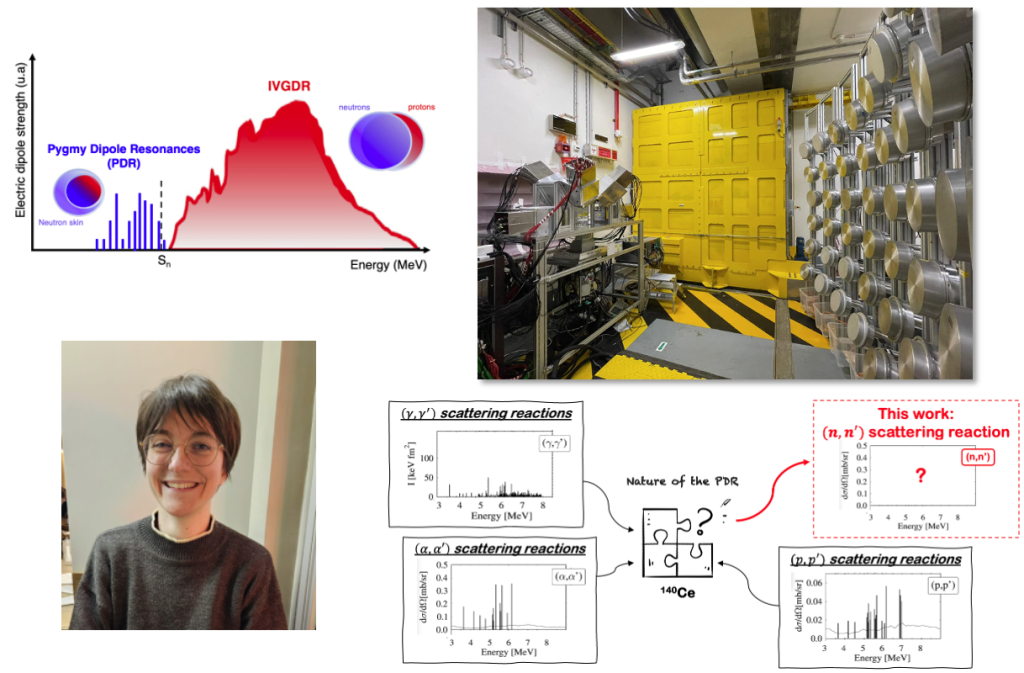
The pygmy dipole resonance (PDR) refers to a low-lying strength in the dipole response of nuclei, located around the neutron separation energy [1] and associated with neutron excess in nuclei. As of today, the available experimental data do not provide an accurate picture of the fine structure of the PDR. These open questions on its structure convey a clear need for more experimental data to pin down its nature and refine theoretical models. In experimental studies of the PDR via inelastic scattering, the so-called “multi-messenger investigation” [2] of the PDR shows a clear advantage to extract complementary information on its nature, depending on the probe used. The experiment I will present fits into this context and offers, for the first time, a study of the PDR using a neutron probe.
The experiment dedicated to the study of the PDR in the 140Ce nucleus via neutron inelastic scattering (n,n’γ) took place in 2022 at the Neutrons For Science facility at GANIL-SPIRAL2 [3]. The ~30 MeV quasi-monoenergetic neutron beams available at the facility, which are unique in terms of intensity, made this study possible. The PARIS [4] and the MONSTER [5] arrays were used for the γ and scattered neutron detection respectively. The detection setup offers very good timing characteristics and a high γ-ray efficiency in the PDR region.
The talk will first present the results for the elastic and inelastic scattering reactions on 12C target used as a benchmark. The presentation will then focus on the results of the study with the 140Ce target, with the extraction of the PDR strength. Finally, conclusions on the interest of the neutron probe and perspectives will be discussed.
References :
[1] A. Bracco, E.G. Lanza, A. Tamii, Prog. Part. Nucl. Phys. 106 (2019) 360-433
[2] D. Savran, T. Aumann, A. Zilges, Prog. Part. Nucl. Phys. 70 (2013) 210-245
[3] X. Ledoux et al., Eur. Phys. J. A 57 (2021) 57:257
[4] F. Camera, A. Maj, PARIS White Book (2021)
[5] A.R. Garcia, T. Martinez, JINST 7 (2012) C05012
Past webinars
You can watch all the previous webinars
on the GdR YouTube channel:

2025
Monday, 26/05 (15h, CET)
Measuring spin-energy correlations in nuclear fission
Nathan GIHA, post doc at IJCLab – Orsay

Despite over eighty years of study since nuclear fission was discovered, important details of this reaction remain poorly understood. Fission plays an important role in r-process nucleosynthesis, where it both defines the termination point of additional neutron captures and the production of light species (A~100-160) by fission recycling. One open question that has generated much interest in the fission community in recent years is that of the mechanism of angular momentum generation in fission. To test the common hypothesis of statistical angular momentum generation, we performed an experiment at Argonne National Laboratory to measure correlations between the angular momenta and excitation energies of fragments. We placed a twin Frisch-gridded ionization chamber loaded with a 252Cf(sf) source inside the Gammasphere HPGe array and simultaneously measured the kinetic energies and masses of the fission fragments and the gamma rays they emitted. Leveraging our knowledge of a fragment’s nuclear level scheme, we reconstructed the spin distribution of 144Ba after neutron and statistical gamma-ray emission as a function of fragment total kinetic energy. We found its average spin to be insensitive to energy—inconsistent with predictions from solely statistical excitation of rotational modes in the fragments.
Monday, 28/04 (15h, CET)
Shell evolution beyond 48Ca : probing exotic cross-shell interactions with 47K(d,p)
Charlie PAXMAN, post doc at GANIL – Caen

Shell evolution in nuclei far from stability, such as those in the region of N>28 and Z<20, is understood to arise from the complex interplay of orbital interactions, with different interactions accessible in unstable nuclei compared to stability. Experimental studies of these exotic regions provide stringent tests of modern shell model interactions, but are difficult to access experimentally. As such, to improve our understanding of exotic structural phenomenon, such as the N=28 « island of inversion », we must attain experimental constraints on these interaction terms.
In this regard, the transfer reaction 47K(d,p)48K provides a unique opportunity to study the exotic pi(s1/2)-nu(fp) interaction in a near-doubly magic nucleus, owing to the unusual pi(s1/2)-hole ground state structure of 47K, which is near-degenerate with the ‘standard’ pi(d3/2)-hole proton configuration in this region. This effectively mimics the structure of the 43P nucleus, which lies in the island of inversion.
The first measurement of the 47K(d,p gamma)48K transfer reaction has been performed at GANIL, in inverse kinematics using a reaccelerated radioactive isotope beam. The level scheme of 48K has been greatly extended, with nine new bound excited states identified and spectroscopic factors deduced. Detailed comparisons with SDPF-U and SDPF-MU shell-model calculations reveal a number of discrepancies between theory and experiment, revealing the structure of 48K to be a crucial step toward accurate predictions of light N=28 nuclei.
Monday, 24/03 (15h, CET)
Proton-neutron pairing in the fp-shell via the 48Cr(p,3He)46V transfer reaction
Hugo Jacob, PhD student at IJCLab – Orsay
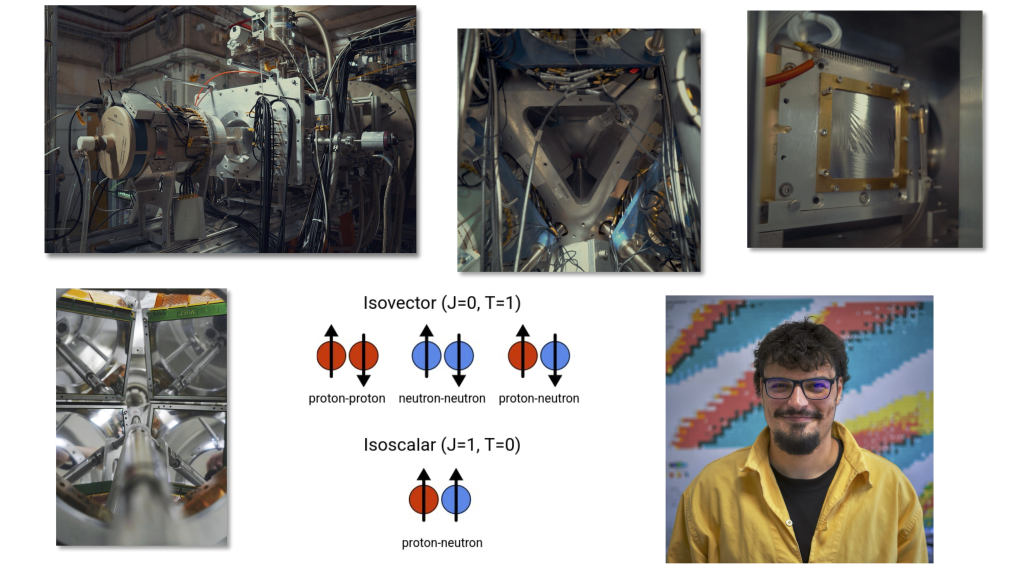
Unlike standard like-particle pairing (neutron-neutron, proton-proton) that exists only in the T=1 channel, proton-neutron pairing can exist in both the T=1 and T=0 channels. This coexistence could explain phenomena such as the overbinding of self-conjugate nuclei. Proton-neutron pairing car be studied by spectroscopy as in ref [1], or by transfert reactions, as in ref. [2], since the two-nucleon transfer reaction cross section is expected to be enhanced by pairing. The relative proton-neutron T = 1 and T = 0 pairing strengths can be accessed by measuring transfert cross sections to the low-lying (J=0+, T = 1) and (J=1+, T = 0) states in odd-odd N=Z nuclei. The (p,3He) reaction can be used, as its selection rules allow to populate both states at once.
As pairing is a collective effect, it is expected to be stronger in the middle of high j orbitals. The f7/2 shell is the highest j shell currently accessible with sufficient beam intensity for two-nucleon transfer reactions in N=Z nuclei. The nucleus 48Cr, lying at the middle of this shell, has been sleeted for study and will be compared with previous experiments in the same region [2]. Moreover, 48Cr is a good candidate for exploring the interplay between pairing correlations and deformation, as it is known to be a good rotor up to spin 10+[3].
The experiment to measure the two-nucleon transfert reaction 48Cr(p,3He)46V was performed in 2023 at GANIL. A radioactive 48Cr beam was produced by fragmentation of a primary 50Cr beam and selected by the LISE spectrometer, before impinging on a CH2 target. A forward array of DSSD-CsI telescopes (MUGAST) was used to detect and identify light charged particles, and was coupled to 12 EXOGAM Germanium clovers around the target, a Zero Degree Detection (ZDD) and MWPC detectors to reconstruct event by event the beam position on the target.
In this seminar, I will present preliminary absolute cross sections and cross section ratios for the low lying states of 46V. The results will be put in perceptive with theoretical models and the systematics in the f-shell : 56Ni(p,3He), 52Fe(p,3He) and 40Ca(p,3He)
References :
[1] B. Cederwall, F. Moradi, T. Bäck, et al., Nature 469, 68-71 (2011)
[2] B. Le Crom, M. Assié, et al., Physics Letters B 829, 137057 (2022)
[3] S. J. Q. Robinson, T. Hoang, L. Zamick, A. Escuderos, Y. Y. Sharon, Phys. Rev. C 89, 014316 (2014).
Monday, 24/02 (15h, CET)
Towards the synthesis of new heavy nuclei : multinucleon transfer reaction with 136Xe + 238U
Jonathan Béquet, PhD Student at CEA Saclay
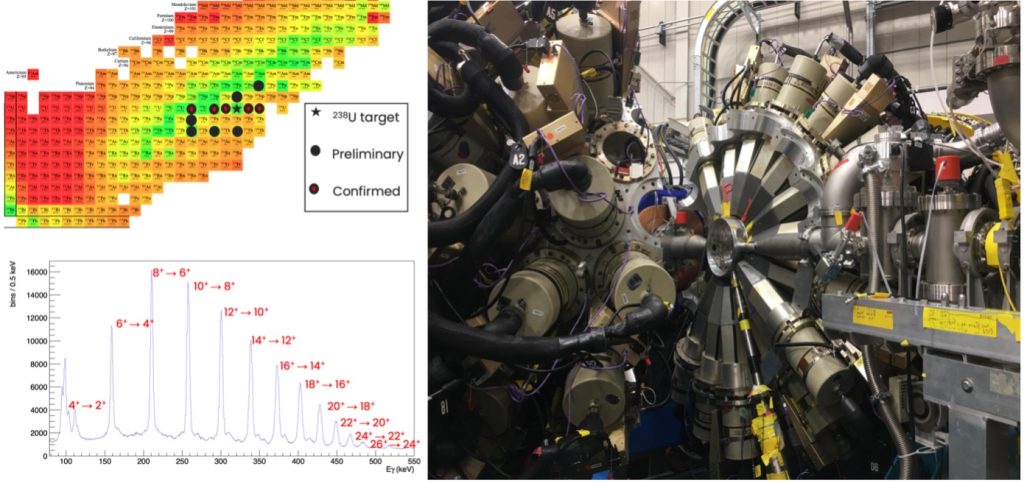
Most of the heaviest nuclei synthesized in recent decades have been obtained using fusion-evaporation reactions. Due to neutron-evaporation, and the limited choice of beam-target combinations, this mechanism tends to produce mainly neutron-deficient nuclei. In addition, the cross-sections are often small, e.g 0.5 pb at most for the discovery of 294Og [1]. Multi-Nucleon Transfer (MNT) reactions are therefore expected to be a complementary mechanism to fusion-evaporation. Indeed, according to the theory [2], this mechanism is well suited to produce neutron-rich heavy ions with relatively high cross sections at forward angles of the order of µbarns.
An experiment was carried out at Argonne National Laboratory in 2023 using a 136Xe beam on a 238U target with detection of the reaction products at forward angles. The setup consisted of the Gammasphere germanium array to perform prompt γ spectroscopy, the AGFA gas-filled separator (with He gas at 4 Torr) to separate the MNT products. A decay station for decay spectroscopy studies was installed at the focal plane, consisting of a DSSD, a PPAC and silicon detectors in a tunnel configuration surrounded by four Clover germanium detectors.
The preliminary results of this analysis will be discussed in this talk.
References :
[1] Yu. Ts. Oganessian et al, Phys. Rev. C 74, 044602 (2006)
[2] V.I. Zagrebaev and W. Greiner, Nuclear Physics A 944:257-307 (2015)
Monday, 27/01 (15h, CET)– ⭐️Special Edition : Tutorial⭐️
Tutorial : introduction to NPTOOL, a versatile tool for data analysis and simulation
Valérian GIRARD-ALCINDOR, senior Scientist at IJCLab (Orsay)
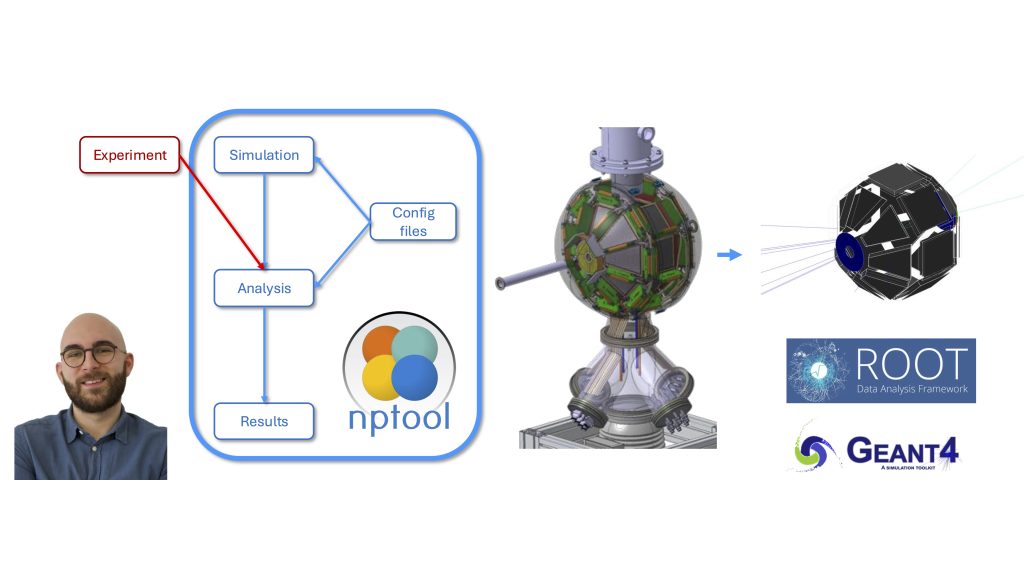
The increasing complexity of nuclear physics experiments often requires the realisation of detailed simulations. These simulations are particularly useful for convincing PAC members but also for convincing yourself that an experiment is actually feasible… Simulations also often play a critical role in the data analysis process itself. However, maintaining consistency between simulations and data analysis can be challenging, as physicists frequently rely on separate codes, which may introduce additional uncertainties.
nptool addresses this issue by offering a unified framework for the simulation and analysis of nuclear physics experiments. It includes a wide selection of detectors, reactions, and other essential tools for nuclear physicists. The software provides a user-friendly interface for ROOT and geant4, along with a clean development environment for users who wish to extend its capabilities or develop custom tools.
This tutorial intends to introduce nptool, its features, and its potential applications. It will provide a step-by-step example of how to run a simulation and analyse its results. It is not meant to be an exhaustive guide to detector development or advanced analysis but will serve as a starting point for new users, offering essential insights into the software’s structure and functionality.
2024
Monday, 22/04 (15h, CET)
Quantum few-body systems and theoretical nuclear physics
Pierre-Yves DUERINCK, PhD student at IPHC(Strasbourg) and ULB (Bruxelles)
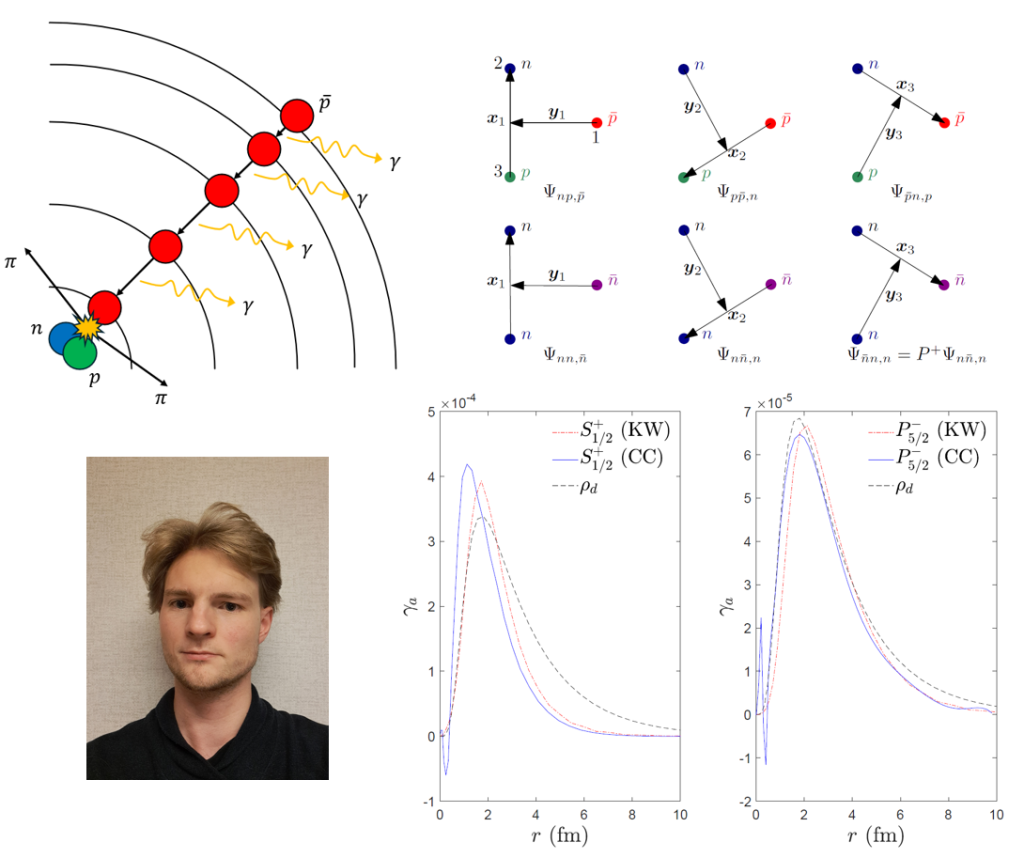
Low-energy antiprotons are known to be promising tools to probe the nuclear structure [1]. In particular, the measurement of antiprotonic atom decays and nucleon-antinucleon annihilation products is expected to provide reliable data to study the tail of nuclear densities, which has motivated the antiProton Unstable Matter Annihilation (PUMA) project [2] at CERN. Although a qualitative picture of what will happen in the PUMA experiments is known, a fully microscopic treatment of the antiproton-nucleus systems remains to be developed. Our main aim is to solve the few-body Schrodinger equation for the cases accessible by ab initio methods. It is also of paramount importance to test the model-dependence of physical observables relative to the nucleon-nucleon and nucleonantinucleon interactions input. Optical potentials are traditionally used to account for the complex annihilation dynamics [3]. In the present work [4], we consider an alternative approach based on a coupled-channel potential, where the annihilation is modelled by the addition of effective meson channels [5]. The model-dependence is investigated by considering the microscopic calculation of the antiproton-deuteron annihilation: the scattering lengths and the resonance energies of the antiprotonic states are computed by solving the Faddeev equations in configuration space [6], and then compared to those obtained with optical models [7].
References :
[1] J. Eades and F. J. Hartmann, Rev. Mod. Phys. 71, 373 (1999).
[2] T. Aumann et al., Eur. Phys. J. A 58, 88 (2022).
[3] C. B. Dover, T. Gutsche, M. Maruyama, and A. Faessler, Prog. Part. Nucl. Phys. 29, 87 (1992).
[4] P.-Y. Duerinck, R. Lazauskas, and J. Dohet-Eraly, Phys. Rev. C 108, 054003 (2023).
[5] E. Ydrefors and J. Carbonell, Eur. Phys. J. A 57, 303 (2021).
[6] L. D. Faddeev, Zh. Eksp. Teor. Fiz. 39, 1459 (1960) ; Sov. Phys. JETP 12, 1014 (1961).
[7] R. Lazauskas and J. Carbonell, Phys. Lett. B 820, 136573 (2021); P.-Y. Duerinck, R. Lazauskas, and J. Carbonell, ibid. 841, 137936 (2023).
Monday, 08/04 (15h, CET)
Structure of exotic nuclei through measurements of magnetic moments of excited nuclear states
Konstantin STOYCHEV, Post-DOC at IJCLab, Orsay
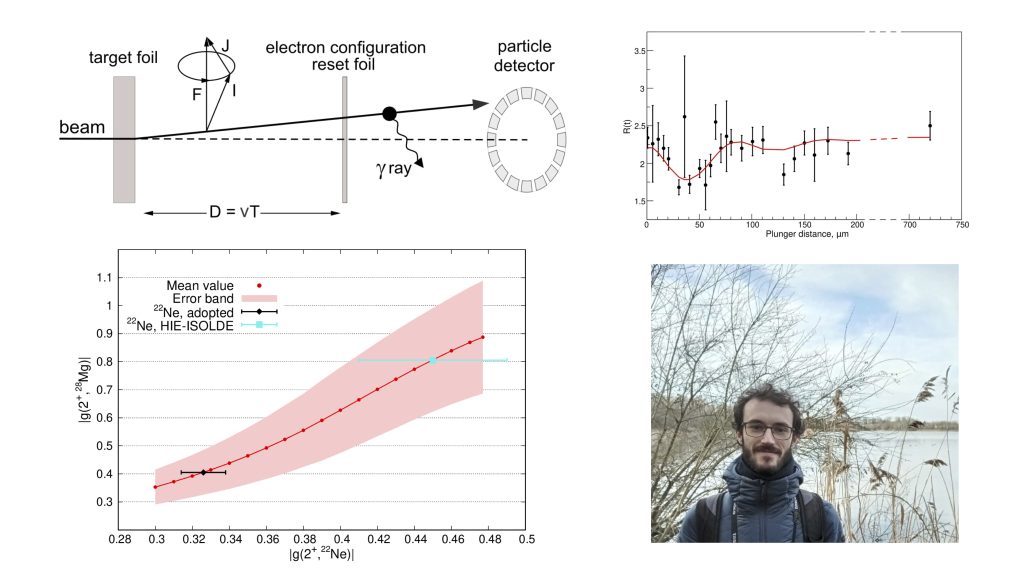
The main topic of this presentation will be to provide an overview of these methods and showcase some examples of their application in several recent (and not so recent) experiments using stable and radioactive ion beams. In particular, the results from the first application of the TDRIV method on a radioactive ion beam of 28Mg performed at HIE-ISOLDE, CERN, and the accompanying calibration TDRIV measurement on 22Ne will be discussed. In addition, results from a TDPAD measurement on isomeric states in the vicinity of 68Ni at NSCL, MSU, and preliminary results from a TDPAC measurement on isomeric states in 98Y at ILL will also be presented. The obtained experimental results will be compared to shell-model calculations. The talk will conclude with the perspectives and plans for future experiments utilizing these methods at facilities worldwide, e.g. GANIL, JYFL, ISOLDE, RIKEN.
Magnetic moments of excited nuclear states are a unique probe of nuclear structure and the experimentally obtained values of magnetic moments are useful to constrain theoretical models. Measurements of magnetic moments in exotic nuclei are sensitive to how nuclear structure evolves far from the line of stability. The mean lifetimes of excited nuclear states can vary with multiple orders of magnitude and over the years different experimental techniques have been developed to measure magnetic moments of excited nuclear states depending on their mean lifetimes. The Time-Differential Recoil In Vacuum (TDRIV) method is applied on excited states with picosecond lifetimes. For isomeric states with half-lives in the range from a few nanoseconds to a few microseconds suitable methods are the Time Dependent Perturbed Angular Distribution (TDPAD) and Time Dependent Perturbed Angular Correlation (TDPAC) methods.
Tuesday, 19/03 (15h, CET)
Exploring the proton drip line in the 48Ni region
Aurora ORTEGA-MORAL (PostDoc at LP2IB – Bordeaux)
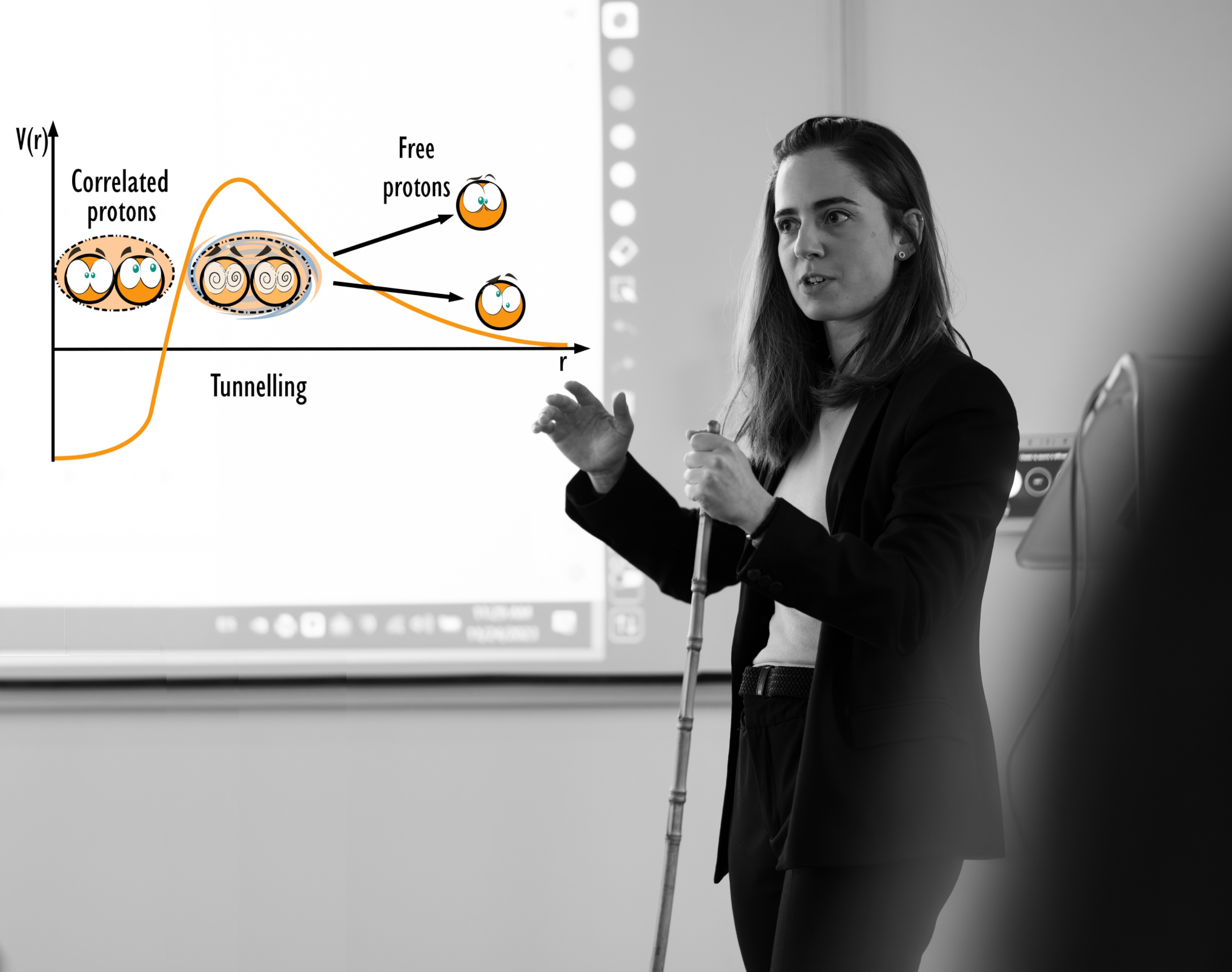
The study of exotic nuclei near the proton drip lines is of great importance for a better understanding of nuclear structure. The two proton radioactivity, a decay mode for neutron deficient isotopes at the proton drip line, was predicted in 1960 and experimentally evidenced in 2002. The angles between the two emitted protons is an important observable that keeps a trace of the interaction of the protons inside the nucleus.
An experiment was performed in 2021 at GANIL to study one of the two-proton emitter nuclei (48Ni) with a Time Projection Chamber (ACTAR TPC), in order to probe the different available predictions for the angular distribution of the emitted protons. During the experiment, other very exotic nuclei in the 48Ni mass region were produced, and their decay products have been also measured. New decays modes have been observed for the first time, such as β-delayed three proton emission for 48Ni and 49Ni or β-delayed two proton emission for 46Mn and 47Fe.
Monday, 19/02 (15h, CET)
Nuclear reaction rates as a key ingredient of stellar modelling: the case of the C12+C12 reaction
Thibaut DUMONT (PostDoc at IPHC – Strasbourg)
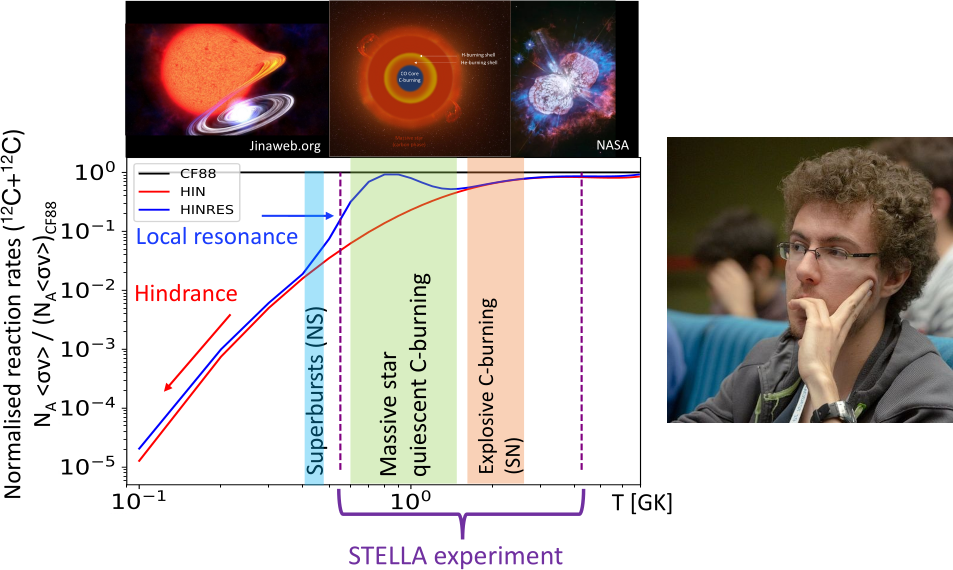
The origin of elements as well as their abundance in the Universe and among stars is at the heart of astrophysics today. Since the Big Bang, chemicals abundances are continuously evolving due to the nucleosynthesis involving different processes with mainly nuclear fusion or particle capture and the subsequent reactions. These processes are taking place in a variety of astrophysical sites, from stars to supernovae and merging events. Stellar evolution codes have been developed to describe the evolution and structure of stars using different physical input ingredients. In particular, the precise determination of the nuclear reaction rates, that drive the stellar evolution, is a crucial ingredient in understanding chemical evolution.
Recently, new nuclear reaction rates have been determined for the different stellar evolution phases by nuclear experiments, potentially leading to significant changes in the nucleosynthesis predictions, with consequences on light and s-process elements abundances. In order to improve stellar modeling, we now need to take into account these new results that can bring one of the key to better constrain stellar evolution and better understand the chemically peculiar stars.
I focused on the C12+C12 nuclear reaction that takes place during the C-burning phase of massive stars (> 8Msol). New direct measurements for the C12+C12 nuclear reaction have been obtained at very low energies by the STELLA collaboration of IPHC-Strasbourg in France. Using the code GENEC, I computed new models for a large range of masses (8 to 30 Msol) exploring different nuclear references and including rotation-induced mixing. Models predictions show that changing the rates drives important changes in the burning lifetime, core characteristics, and resulting abundances of stars, impacting their evolution and end-of-life. The choice for the nuclear reaction rates reference among the available literature is consequently of significant importance and should be taken with precautions.
Monday, 05/02 (15h, CET)
Nuclear interactions from effective theories to ab initio methods
Lorenzo CONTESSI (PostDoc at IJClab – Orsay)
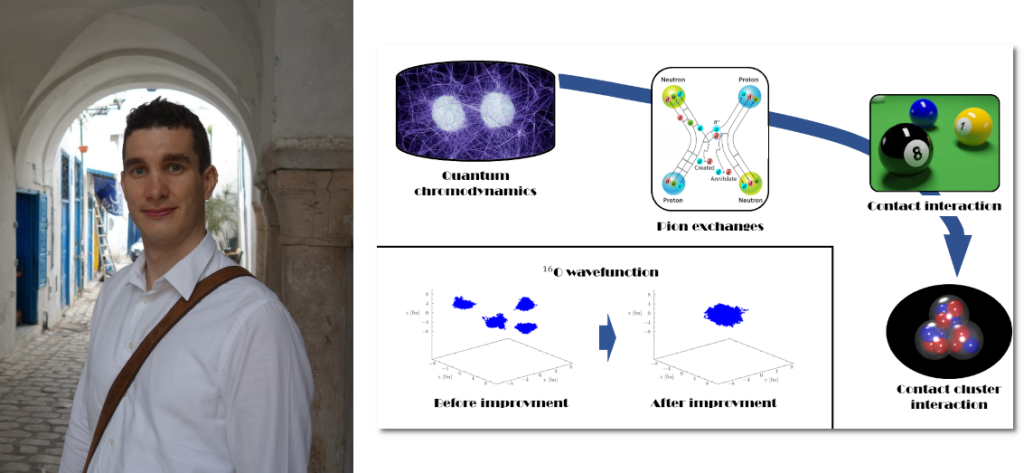
Energy levels of exotic nuclei, reaction rates, and equations of state for neutron stars are among the various properties that nuclear theory seeks to describe. Ab initio methods aim to calculate these observables by treating nucleons as fundamental degrees of freedom. This approach is gaining popularity due to its ability to address diverse systems with an unified formalism. Moreover, the consistent advancements in numerical methods and capabilities have further supported these approaches, enabling simulations of progressively larger systems from first principles.
However, nuclear physics encounters another non-trivial challenge: the complexity of defining nuclear forces. Over the past two decades, effective field theories have transformed the way nuclear interactions have been designed, favoring systematic improvability and theoretical error estimations. To optimize nuclear calculations and increase the size of systems approachable ab initio, it is fundamental to join numerical and theoretical efforts, making theory and numerics synergize to achieve the most precise results even in exotic systems.
This seminar will showcase recent efforts using the improved action method [1] to leverage the flexibility in designing effective theories and simplify many-body numerical calculations without compromising the good analytic properties of renormalizable effective interactions. The goal is to create theories that can be seamlessly integrated into numerical methods, even for large systems. The advantages of this method will be described, along with its future prospects.
[1] L.C., Martin Schäfer, Ubirajara van Kolck, Improved action for contact effective field theory, arXiv:2310.15760
Monday, 22/01 (15h, CET)
Pear-shaped nuclei in the actinides : Decay spectroscopy of 225Pa
Emmanuel REY-HERME (PostDoc at LP2I-Bordeaux)
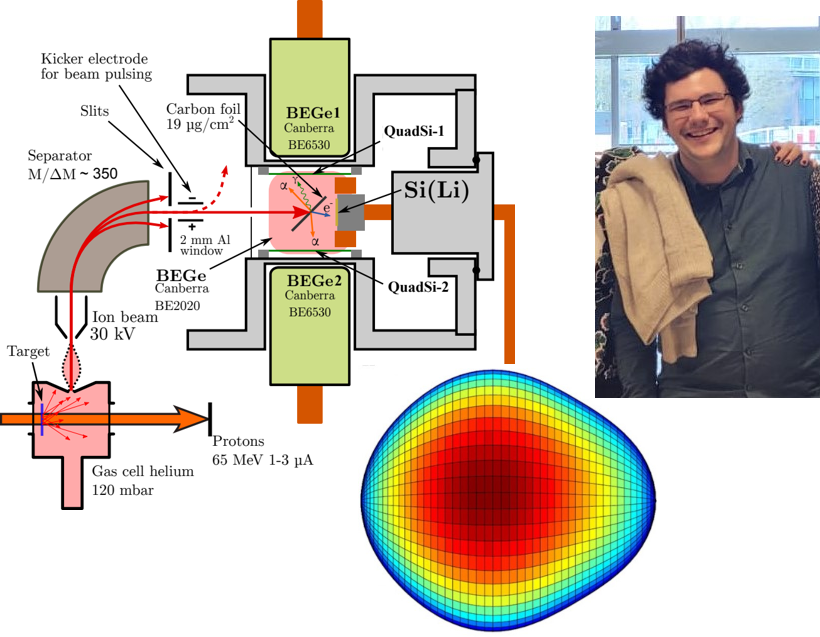
The study of the structure of neutron-deficient actinides is of particular interest since several theoretical calculations predict strong octupole deformations in this region of the nuclear chart. However experimental data are scarce due to very low production rates. There is an ongoing program at the IGISOL (Ion Guide Isotope Separation On-Line) facility, University of Jyväskylä, to study actinide isotopes, including the decay spectroscopy of neutron-deficient actinides produced through proton-induced fusion-evaporation reactions on a 232Th target. A successful experiment was performed in July 2020 where short-lived actinide isotopes were produced, mass separated and guided to a decay spectroscopy station. Using an experimental setup composed of Ge, Si and Si(Li) detectors, α, γ and electron decay spectroscopy of the selected nuclei was performed to reconstruct the decay schemes that are missing or incomplete in this region of the nuclear chart. In this presentation, I will show results focusing on 225Pa, for which very little decay information was available before this experiment, as well as its daughter nucleus 221Ac. Reconstruction of the decay scheme and measurement of α hindrance factors indicates a static quadrupole-octupole deformation in 221Ac. In particular the level scheme of 221Ac is interpreted in terms of parity-doublet bands arising from this octupole deformation.
The second goal of this experiment was to measure production yields in order to consider a laser spectroscopy program in the future. Indeed laser ionization spectroscopy is well established as a powerful tool in nuclear structure studies. It allows the measurement of spins, magnetic dipole moments, electric quadrupole moments and changes in the mean-square charge radii independently of nuclear models. In the near future, the possibility to perform laser ionization spectroscopy of neutron-deficient actinides at S3-LEB will allow this program to continue towards nuclei further from stability. In particular the SEASON (Spectroscopy Electron Alpha in Silicon bOx couNter) detector will enable the coupling of two approaches : laser ionization spectroscopy and decay spectroscopy. I will conclude my talk discussing perspectives for the study of octupole deformations in the neutron-deficient actinides, in particular those offered by SEASON at S3-LEB and at Jyväskylä.
The second goal of this experiment was to measure production yields in order to consider a laser spectroscopy program in the future. Indeed laser ionization spectroscopy is well established as a powerful tool in nuclear structure studies. It allows the measurement of spins, magnetic dipole moments, electric quadrupole moments and changes in the mean-square charge radii independently of nuclear models. In the near future, the possibility to perform laser ionization spectroscopy of neutron-deficient actinides at S3-LEB will allow this program to continue towards nuclei further from stability. In particular the SEASON (Spectroscopy Electron Alpha in Silicon bOx couNter) detector will enable the coupling of two approaches : laser ionization spectroscopy and decay spectroscopy. I will conclude my talk discussing perspectives for the study of octupole deformations in the neutron-deficient actinides, in particular those offered by SEASON at S3-LEB and at Jyväskylä.
Monday, 08/01 (15h, CET)
Advances in Many-Body Perturbation Theory for Closed- and Open-Shell Nuclei
Zhen LI (PhD Student at LP2I-Bordeaux)

It is one of the ultimate goals of theoretical nuclear physicist to calculate properties of atomic nuclei starting from realistic internucleon interactions. For light nuclei, the exact diagonalization of the Hamiltonian matrix in a sufficiently large Hilbert space, namely the no-core shell model [1], is able to provide very accurate calculations. However, when dealing with not very light nuclei, the size of the Hilbert space quickly becomes intractable. Therefore, specific many-body methods should be developed to surmount this problem. One strategy is to project the Schrödinger equation into a small model space, called P-space, by constructing an effective Hamiltonian, and then to solve the Schrödinger equation in the P-space.
In this talk we describe many-body perturbation theory (MBPT) as an approach to compute such effective Hamiltonians [2, 3], applicable for both closed-shell nuclei and open-shell nuclei (i.e., the valence-space effective Hamiltonian for the nuclear shell model calculation). The main goal is to incorporate effectively the information on nucleonic excitations from the excluded part of the Hilbert space (the complement of the P-space) into the P-space. I will present new developments of MBPT performed within both Brillouin-Wigner (BW) and Rayleigh-Schrödinger (RS) formalisms.
Although the BW perturbation series contains the undesired energy dependence, it has a simple algebraic structure. A novel approach is proposed [2] to efficiently perform iterative calculations and study the order-by-order convergence of MBPT in powers of the nucleon-nucleon interaction. Analytic calculations show that we can always make the BW perturbation series for the nuclear ground state converging (independently of the choice of the nucleon-nucleon interaction or the choice of the many-body basis) due to the variational principle. Numerical calculations for 4He, 16O and some selected p-shell nuclei with a new K-box iterative method confirm this finding.
RS MBPT in the diagrammatic representation is widely applied to nuclear ground-state calculations [4] and effective-Hamiltonian constructions for the nuclear shell model [5]. However, existing applications of this diagrammatic method usually stop at 3rd, because of the prohibitive number of diagrams involved at higher orders. We advance this diagrammatic formulation of RSMBPT beyond the conventional 3rd order, by implementing automatic generation and evaluation of Feynman-Goldstone diagrams. This allows us to compute nuclear ground states up to 6th order and derive valence-space effective Hamiltonians up to 5th order.
We believe that these developments build further the path to ab-initio description of atomic nuclei.
References :
[1] B.R. Barrett, P. Navrátil, and J.P. Vary. Ab initio no core shell model. Prog. Part. Nucl. Phys. 69, 131 (2013).
[2] Zhen Li and Nadezda A. Smirnova. Converging Many-Body Perturbation Theory for Ab Initio Nuclear- Structure: I. Brillouin-Wigner Perturbation Series for Closed-Shell Nuclei. arXiv:2306.13629 (2023).
[3] Zhen Li, Advances in Many-Body Perturbation Theory for Closed- and Open-Shell Nuclei, Ph.D. thesis (2023), to be published.
[4] Alexander Tichai, Robert Roth, and Thomas Duguet. Many-body perturbation theories for finite nuclei. Front. Phys. 8, 164 (2020).
[5] L. Coraggio, A. Covello, A. Gargano, N. Itaco, and T.T.S. Kuo. Shell-model calculations and realistic ef ective interactions. Prog. Part. Nucl. Phys. 62, 135 (2009).
2022
Monday, 13/06 (16h, CET)
Study of the two-neutron decay of 13Li via the invariant mass method with SAMURAI@RIBF
Paul ANDRE (PhD Student at CEA-Saclay)
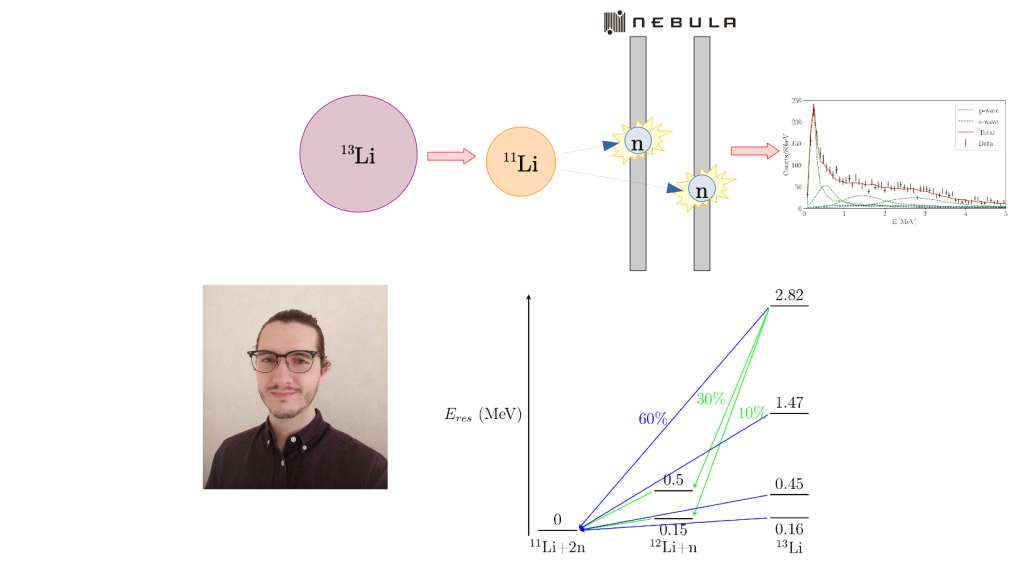
13Li is a neutron-rich unbound nucleus that decays into the halo nucleus 11Li via the emission of two neutrons. Studying such a system can lead to a better understanding of neutron-neutron correlations in the atomic nucleus. This study has been performed using the SAMURAI facility [1] at RIBF, RIKEN, Japan, with a high-intensity beam and a setup with large acceptance, allowing a better resolution and efficiency than achieved in past measurements at GSI [2] and NSCL [3].
A beam of 14Be impinges on the liquid hydrogen MINOS target [4], producing the 13Li isotopes via a (p,2p) reaction. The vertex of interaction is then reconstructed thanks to the tracking system around the target. The two decay neutrons are detected in the NEBULA array, and the remaining 11Li is detected in a hodoscope [5]. Thanks to the reconstruction of the momenta of all the decay products with the aforementioned detectors, the invariant masses of the 11Li-n-n system, the 11Li-n system and the n-n system are computed. With this quantity, more information on the spectroscopy of 13Li, such as the energy of the neutron resonances, can be provided. Using correlation plots of the Jacobi coordinates of the system [6], information on the nature of the decay (e.g. sequential or direct) can also be deduced.
References :
[1] T. Nakamura, Y. Kondo, Nucl. Instrum. Methods Phys. Res. B 376 (2016) 156-161
[2] Yu. Aksyutina et al., Phys. Lett. B 666 (2008) 430-434
[3] Z. Kohley et al., Phys. Rev. C 87 (2013) 011304(R)
[4] A. Obertelli et al., Eur. Phys. J A 50 (2014)
[5] T. Kobayashi et al., Nucl. Instrum. Methods Phys. Res. B 317 (2013) 294-304
[6] R.J. Charity et al., Phys. Rev. C 84 (2011) 014320
Monday, 30/05 (16h, CET)
Measurements of 12C fusion at deep sup-barrier energies with STELLA
Jean NIPPERT (PhD Student at IPHC-Strasbourg)
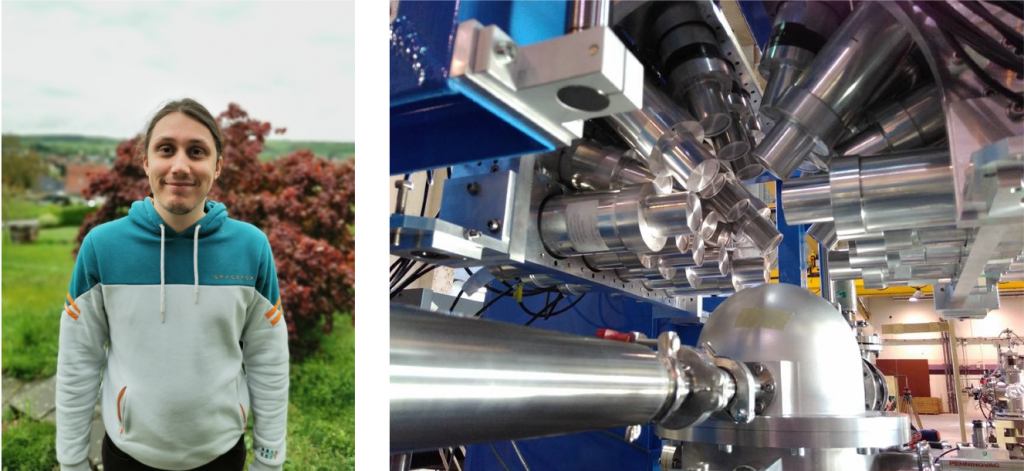
Carbon burning is an important phase of the massive stars evolution. It occurs mainly through the 12C + 12C fusion reaction. This reaction is also very specific in terms of nuclear physics due to the identification of oscillation in the cross section at energies above and below the Coulomb barrier. The energy region of astrophysical interest is located deeply below the Coulomb barrier, where the cross section is dropping down to the picobarn range, making its measurement extremely challenging. The STELLA apparatus has been developed to measure such deep sub-barrier cross sections using gamma-particle coincidences.
The context of the 12C + 12C fusion reaction will be discussed in this presentation, as well as how the STELLA experiment aims to tackle the challenge of the 12C + 12C cross section measurement. In this presentation, we shall discuss the possible occurrence of fusion hindrance in 12C + 12C at deep sub-barrier energies, as observed in most systems. This phenomenon may change our understanding of massive stars evolution.
Monday, 09/05 (16h, CET)
Experimental Study of the 30Si(p,γ)31P for understanding elemental anomalies in Globular Clusters.
Sarah HARROUZ (PhD Student at IPN-Orsay)
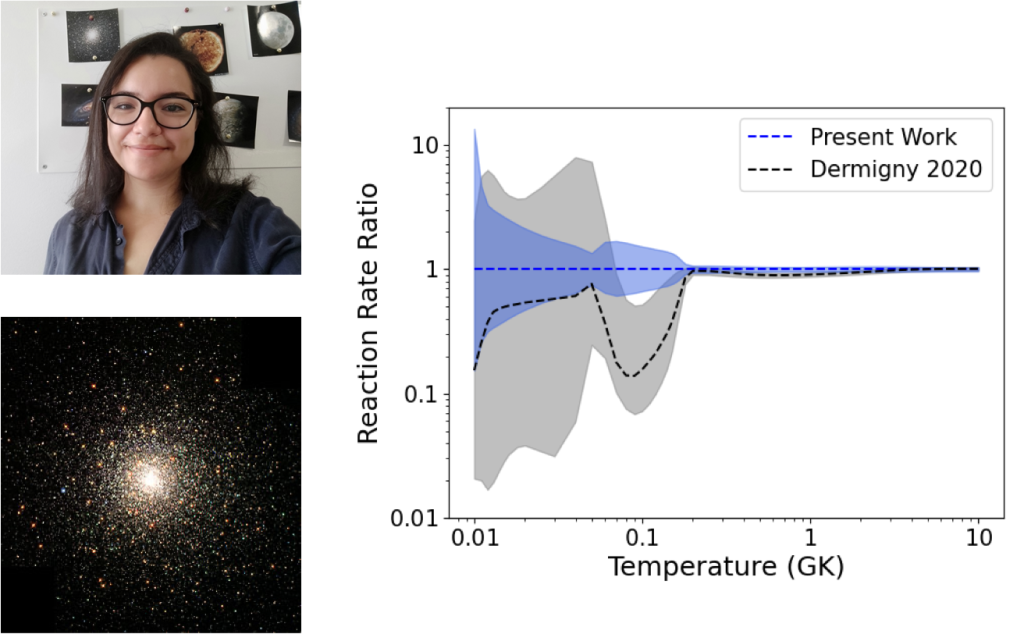
In collaboration with: N. de Séréville, P. Adsley, F. Hammache, R. Longland, B. Bastin, T. Faestermann, R.Hertenberger, M. La Cognata, L. Lamia, A. Meyer, S. Palmerini, R. G. Pizzone, S. Romano, A. Tumino, and H.-F. Wirth.
Globular clusters are key grounds for models of stellar evolution and early stages of the formation of galaxies. Abundance anomalies observed in the globular cluster NGC 2419, such as the enhancement of potassium and depletion of magnesium [1] can be explained in terms of an earlier generation of stars polluting the presently observed stars [2]. However, the nature and the properties of the polluting sites are still debated. The range of temperatures and densities of the polluting sites depends on the strength of a number of critical thermonuclear reaction rates. The 30Si(p,γ)31P reaction is one of the few reactions that have been identified to have an influence for elucidating the nature of polluting sites in NGC 2419 [3]. The current uncertainty on the 30Si(p,γ)31P reaction rate has a strong impact on the range of possible temperatures and densities of the polluter sites.
Hence, we investigated the 30Si(p,γ)31P reaction with the aim to reduce the associated uncertain- ties by determining the strength of resonances of astrophysical interest. In this talk I will present the study of the reaction 30Si(p,γ)31P that we performed via the one proton 30Si(3He,d)31P transfer reaction at the Maier-Leinbnitz-Laboratorium Tandem. With the high resolution Q3D magnetic spectrograph, we measured the angular distributions of the light reaction products. These angular distributions are interpreted in the DWBA (Distorted Wave Born Approximation) framework to determine the proton spectroscopic factor information needed to determine the proton partial width of the states of interest. This information was used to calculate the 30Si(p,γ)31P reaction rate. The uncertainties on the reaction rate have been significantly reduced and key remaining uncertainties have been identified.
References:
[1] C. Iliadis et al., The Astrophysical Journal, vol. 470, p. 98, Feb. 2016.
[2] R. G. Gratton et al., The Astronomy and Astrophysics Review, vol. 20, p. 50, Feb. 2012.
[3] J. R. Dermigny and C. Iliadis, The Astrophysical Journal, vol. 848, p. 14, Oct. 2017.
Tuesday, 19/04 (16h, CET)
Investigation of isomeric states in 255Rf
Rikel CHAKMA (PostDoc at GANIL-Caen)
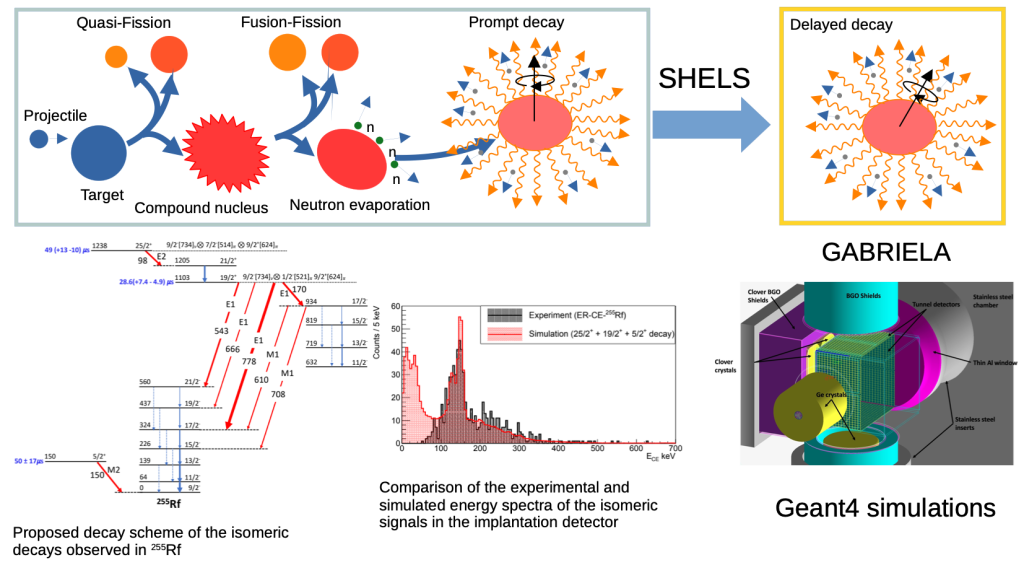
Heavy and super-heavy nuclei are of general interest to study the tug of war between electromagnetic and nuclear forces. Determining the nature and sequence of states in these nuclei is crucial in understanding the different interactions and the dynamics at play, but yet remains challenging both theoretically and experimentally. A viable experimental approach is to search for and study low-lying metastable states since their decay properties depend on the available orbitals near the Fermi surface. Around the N = 152 single-particle gap, isomeric states in 254Rf[1], 256Rf[2, 3] and 257Rf[4] have been studied in detail. Thus, it seemed logical to look for isomeric states in 255Rf. In this isotope, two high-K isomers at excitation energies around 0.9-1.45 MeV, spins ≥ 17/2h (suggested tentatively) and half-lives T = 38+12μs and T = 15+6μs have been observed[5]. Another isomer around 135 keV 1/2 −7 1/2 −4 with a half-life of 50 ± 17μs has also been observed in an alpha decay study of 259Sg to 255Rf and was inferred to be a spin isomer from the systematic of N = 151 isotones[6]. We have carried out an ex- periment to populate isomeric states of 255Rf by the fusion-evaporation reaction 50Ti(207Pb,2n)255Rf. The beam 50Ti of 300 pnA was delivered by the U400 accelerator at FLNR, Dubna. The evaporation residues were separated from the background using SHELS[7], which were then implanted into the focal plane detector of the GABRIELA multidetector array[8, 9]. Using GABRIELA, it is possible to make time and position correlations between the implanted nuclei and their subsequent decays. Experimental decay spectra were interpreted using Geant4[10] simulations. New results from the Geant4 assisted spectroscopy on the isomeric decay properties of 255Rf will be discussed.
References :
[1] H. M. David et al., PRL 115, 132502 (2015)
[2] H. B. Jeppesen et al. Phys. Rev. C 79, 031303(R) (2009)
[3] A. P. Robinson et al. Phys. Rev. C 83, 064311 (2011)
[4] J. Rissanen et al. Phys. Rev. C 88, 044313, (2013)
[5] P. Mosat et. al., Phys. Rev. C, 101, 034310, (2020)
[6] S. Antalic et al., Eur. Phys. J. A, 51, 41 (2015)
[7] A.G. Popeko et al., Nucl. Instr. and Meth. B 376, 140-143, (2016)
[8] R. Chakma et al., Eur. Phys. J. A 56, 245,(2020)
[9] K. Hauschild et al., Nucl. Instr. and Meth. A 560, 388 (2006)
[10] S. Agostinelli et al., Nucl. Instr. Meth. A 506, 250-303,(2003)
Monday, 21/03 (16h, CET)
Tidal Disruption Events: what can we learn from them?
Martina TOSCANI (PostDoc at L2IT-Toulouse)
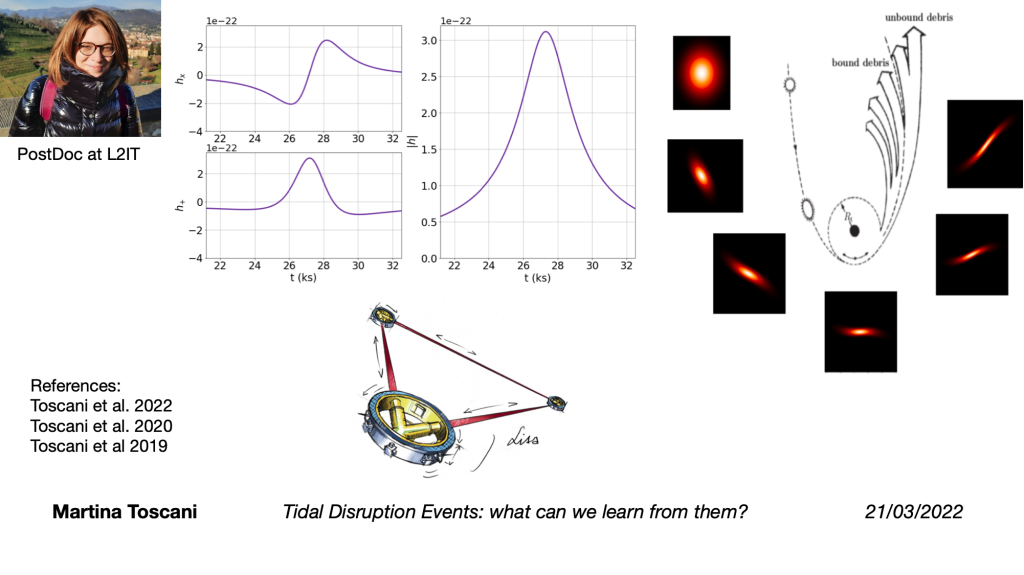
Tidal Disruption Events (TDEs) are extremely powerful phenomena that take place when a star, passing by a massive black hole (BH), is stripped away due to the tides induced by the BH. After the disruption, roughly half of the star is expected to circularize around the BH and form an accretion disc.
These events are a treasure trove of astrophysical information, that can be extracted (i) from their electromagnetic radiation produced during the disruption and the accretion process, (ii) from the astrophysical neutrinos generated within the circularization phase and (iii) from gravitational waves (GWs) produced along the entire process.
In this talk, I will focus on the GW radiation from these events, in particular illustrating the results of Toscani et al. 2020 and Toscani et al. 2021. I will show how, thanks to the study of this emission, it is possible to extract information about the BH distribution through the universe, BH spin, stellar dynamics and, possibly, also the internal structure of the star.
Monday, 07/03 (16h, CET)
NeAb-initio description of the monopole resonance in light- and medium-mass nuclei∗
Andrea PORRO (PhD student at CEA-Saclay)
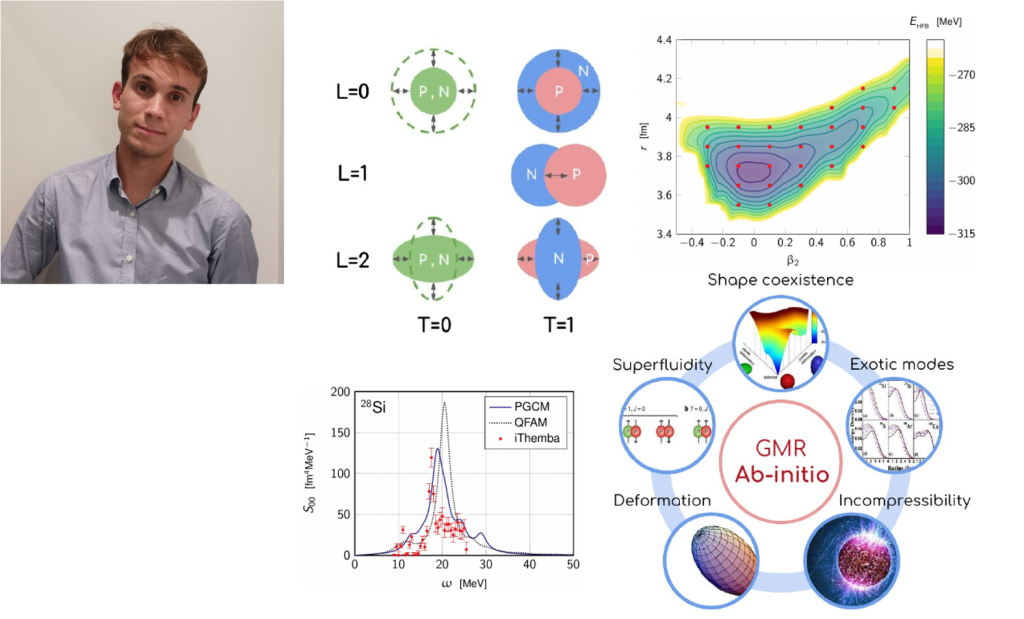
Giant monopole resonances have a long-standing theoretical importance in nuclear structure. The interest resides notably in the so-called breathing mode that has been established as a standard observable to constrain the nuclear incompressibility [1]. The Random Phase Approximation (RPA) within the frame of phenomenological Energy Density Functionals (EDF) has become the standard tool to address (monopole) giant resonances and extensive studies, mostly in doubly-closed-shell systems, have been performed throughout the years, including via the use of so-called sum rules [2]. A proper study of collective excitations in the ab-initio context is, however, missing.
In this perspective, the first systematic ab-initio predictions of (giant) monopole resonances will be presented [3]. Ab-initio Quasiparticle-RPA (QRPA) [4] and Projected Generator Coordinate Method (P-GCM) [5] calculations of monopole resonances are compared in light- and mid-mass closed- and open- shell nuclei, which allows in particular to investigate the role of superfluidity from an ab-initio standpoint. Sum rules are also employed within both many-body schemes to characterize the fragmentation of the monopole strength. The study further focuses on the dependence of the results on the starting nuclear Hamiltonian derived within the frame of chiral effective field theory.
Monopole resonance represents, thus, the first step towards the investigation of higher multipolarities. Eventually, the mid-term goal to establish P-GCM as a new method to study resonances in the light- and medium-mass region of the nuclide chart will be discussed: interpretation and analysis of resonance data in lighter nuclei is a very demanding task on which ab-initio P-GCM could shed new promising light.
References
[1] J. P. Blaizot, D. Gogny, and B. Grammaticos, “Nuclear compressibility and monopole resonances,” Nuclear Physics A, vol. 265, pp. 315–336, July 1976.
[2] O. Bohigas, A. Lane, and J. Martorell, “Sum rules for nuclear collective excitations,” Physics Reports, vol. 51, pp. 267–316, Apr. 1979.
[3] A. Porro, M. Frosini, T. Duguet, V. Som ́a, Y. Beaujeault-Taudi`ere, J.-P. Ebran, and R. Roth To be published, 2021.
[4] Y. Beaujeault-Taudi`ere and J.-P. Ebran To be published, 2021.
[5] M. Frosini, T. Duguet, J.-P. Ebran, R. Roth, V. Som ́a, and A. Tichai, “Application of Projected Generator Coordinate Method to ab-initio description of Ne isotopes,” To be published, 2021.
Monday, 14/02 (16h, CET)
New results on the decay spectroscopy of 254No with GABRIELA@SHELS
Margaux FORGE (PhD Student at IPHC – Strasbourg)
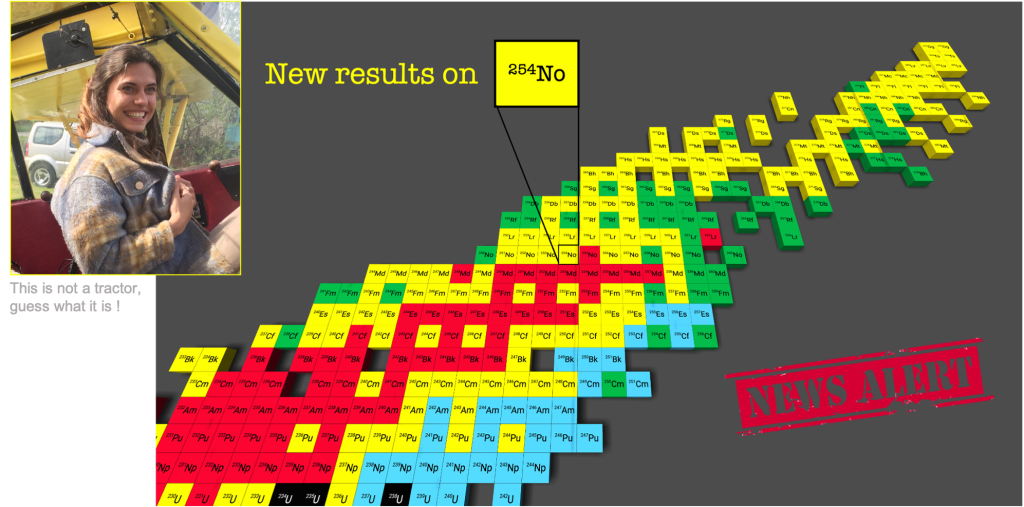
The structure of the 254No nucleus has been studied for more than 20 years: the last publications on the decay spectroscopy are from four experiments performed at LBNL [1], GSI [2], JYFL [3] and ANL [4]. Four decay schemes featuring two isomers have been published. These are interpreted as 2 and 4qp states. Unfortunately, while the authors agree on the excitation energy and decay scheme of the 2-qp ∼260 ms 8- isomer, they disagree on the configuration assignment for both the 8- and the shorter-lived ∼180 μs 4-qp isomer and differ considerably on the excitation energy and decay scheme of the 4qp isomer. These discrepancies have triggered new experiments worldwide, for example the combined prompt and decay spectroscopy performed using SAGE and GREAT [5]. We report here on an experiment performed with the GABRIELA [6] array, at the focal plane of the SHELS [7] separator at the FLNR, Dubna.
The 254No nucleus was produced using the cold fusion-evaporation reaction 48Ca(208Pb, 2n)254No. The first part of this talk will present the experimental setup and the analysis techniques used to reveal the electromagnetic decay of the known isomers in 254No. The second part will focus on the new results obtained. Due to the combination of a higher transmission of the separator (as compared to VASSILISSA [8]) and an increased efficiency of the upgraded GABRIELA array [9], more than 1 million 254No nuclei were implanted in the focal plane detector enabling the electromagnetic decay of the short and long-lived isomers to be studied in more detail. In particular, the internal conversion electron spectrum observed in decay of the 8- isomer has revealed the presence of a strong transition, possibly E0, suggesting low-lying shape coexistence in this nucleus as predicted in [10]. Finally, the gamma spectrum obtained from the decay of the short-lived isomer has revealed new peaks that will be attempted to be placed in the new decay scheme. The spectroscopic information extracted from alpha, gamma and electron correlations will be presented and discussed in terms of the likely underlying single-particle structure.
References :
[1] R.M Clark et al., Phys. Lett. B 690, 19 (2010).
[2] F.P. Hessberger et al., Eur. Phys. J. A 43, 55 (2010).
[3] R.-D. Herzberg et al., Nature 442, 896 (2006).
[4] S.K. Tandel et al., Phys. Rev. Lett. 97, 082502 (2006).
[5] A. Ward PhD, University of Liverpool (2016).
[6] K. Hauschild et al., Nucl. Instr. Methods A 560, 388-394 (2006).
[7] A.G. Popeko et al., NIM B 376, 140-143 (2016).
[8] O.N. Malyshev et al., Nucl. Instrum. Methods Phys. Res. A 440, 86 (2000).
[9] R. Chakma et al., Eur. Phys. J. A 56, 245 (2020).
[10] J.-P. Delaroche et al., Nucl. Phys. A 771, 103-168 (2006).
2021
Monday, 13/12 (16h, CET)
Ab initio computation of Sn and Xe charge densities
Pierre ARTHUIS (PostDoc at the TU Darmstadt)
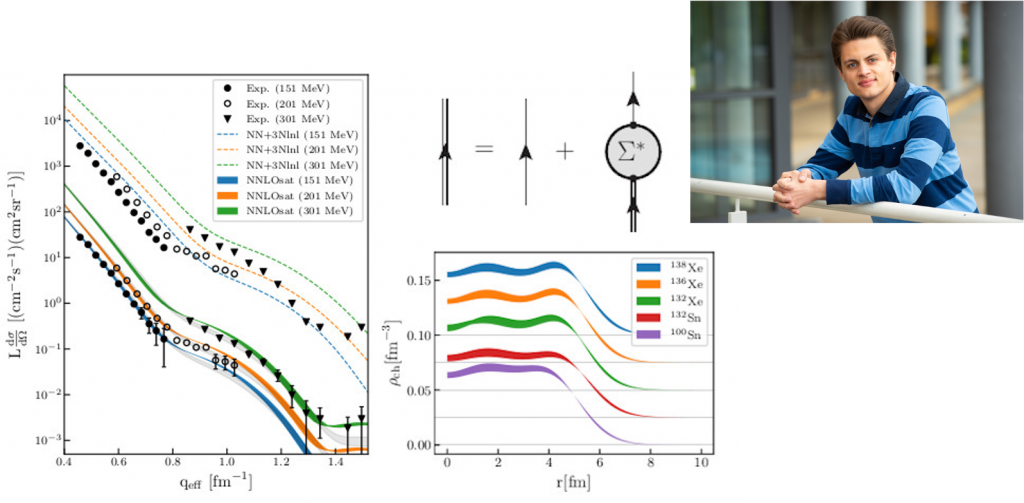
Over the past decade, ab initio methods for finite nuclei have expanded their reach towards larger masses and gained both in precision and complexity. While limitations of the interactions and convergence issues had for long restricted the relevance of results in and to the mid-mass domain, those restrictions are now being lifted. In this seminar, after introducing ab initio methods and their recent progress [1], I will detail how we investigated nuclei at the limit of the ab initio mass range in a recent study on Sn and Xe isotopes [2] that focused on charge radii and densities and reproduced scattering results from the SCRIT experiment [3].
References :
[1] H. Hergert, Front. Phys. 8, 379 (2020), https://doi.org/10.3389/fphy.2020.00379
[2] P. Arthuis, C. Barbieri, M. Vorabbi and P. Finelli, Phys. Rev. Lett. 125 18, 182501 (2020),https://doi.org/10.1103/PhysRevLett.125.182501
[3] K. Tsukada, A. Enokizono, T. Ohnishi, K. Adachi, T. Fujita, M. Hara, M. Hori, T. Hori, S. Ichikawa, K. Kurita, K. Matsuda, T. Suda, T. Tamae, M. Togasaki, M. Wakasugi, M. Watanabe, and K. Yamada, Phys. Rev. Lett. 118, 262501 (2017),https://doi.org/10.1103/PhysRevLett.118.262501
Monday, 29/11 (16h, CET)
The NECTAR project and solar cell studies
Michele SGUAZZIN (PhD student in CENBG-Bordeaux)
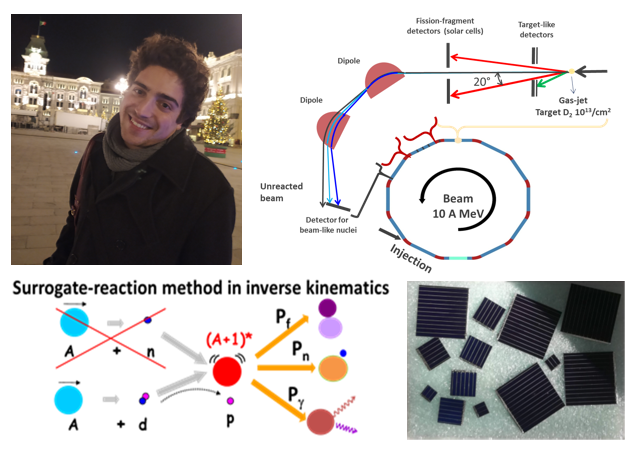
Obtaining reliable cross sections for neutron-induced reactions on unstable nuclei is a highly important task and a major challenge. These data are essential for understanding the synthesis of heavy elements in stars and for applications in nuclear technology. However, their measurement is very complicated as both projectile and target are radioactive. The NECTAR (NuclEar reaCTions At storage Rings) project aims to circumvent these problems by using the surrogate reaction method in inverse kinematics., where the nucleus formed in the neutron-induced reaction of interest is produced by a reaction (typically a transfer or an inelastic-scattering reaction) involving a radioactive heavy-ion beam and a stable, light target nucleus. The probabilities as a function of the compound-nucleus excitation energy for gamma- ray emission, neutron emission and fission, which can be measured with the surrogate reaction, are particularly useful to constrain model parameters and to inform more accurate predictions of neutron- induced reaction cross sections.
The objective of the NECTAR project is to combine surrogate reactions with the unique and largely unexplored possibilities at heavy-ion storage rings, in order to measure the decay probabilities with unrivaled accuracy. However, the ultra-high vacuum (UHV) conditions inside the storage rings pose severe constraints to in-ring detection systems.
In this contribution, we will present the conceptual idea of the setup, which will be developed within NECTAR to measure for the first time simultaneously the fission, neutron and gamma-ray emission probabilities at the storage rings of the GSI/FAIR facility. We will also discuss the technical developments that are being carried out towards these measurements, focusing on the use of solar cells to build an in- ring detection system for fission fragments.
In this latter frame, we will explain why solar cells are an appealing alternative to silicon detectors for the detection of heavy ions, and we will present the main results of recent experiments where we have investigated the radiation hardness, energy and time resolution, and UHV compatibility of solar cells.
Monday, 15/11 (16h, CET)
Constraining the Equation of State of dense matter in neutron stars using multi-messenger observations.
Rahul SOMASUNDARAM (PhD student in IP2I-Lyon)
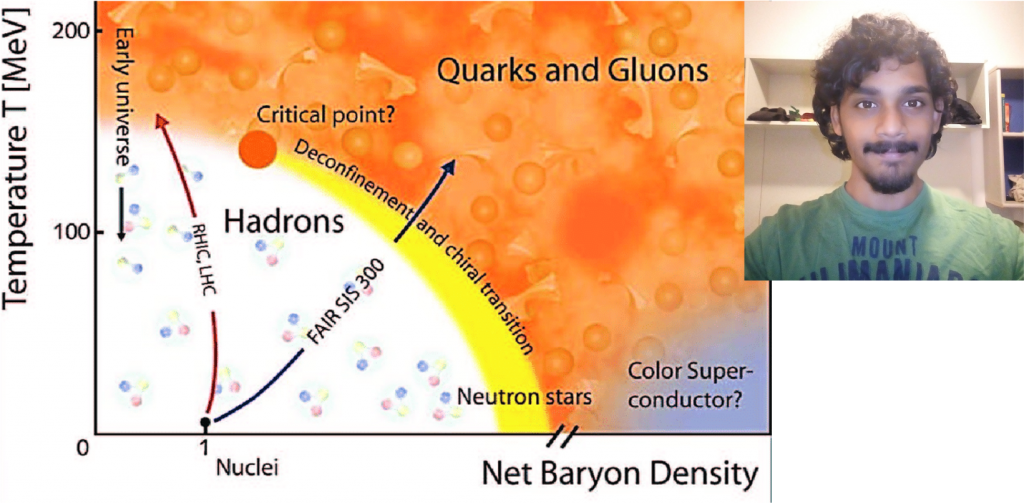
Neutron stars are one of the most fascinating objects in the universe, exploring matter at the highest densities that we can observe. Recent radio, X-ray and gravitational wave observations have constrained the global properties of neutron stars such as their masses, radii and tidal deformabilities, giving us valuable new insights into the Equation of State of dense matter.
Simultaneously, there has been significant efforts on the theoretical modeling of the dense matter Equation of State. In this seminar, I will discuss how state-of-the-art calculations exploiting the chiral symmetry of QCD can be used to make predictions for nucleonic matter present in the cores of neutron stars. Additionally, we will explore the plausible existence of exotic, i.e. non-nucleonic matter in neutron stars, and how one could potentially use recent experimental data to detect their presence.
Monday, 18/10 (16h, CET)
Universal Systems and Effective Field Theories
Lorenzo CONTESSI (PostDoc in CEA)
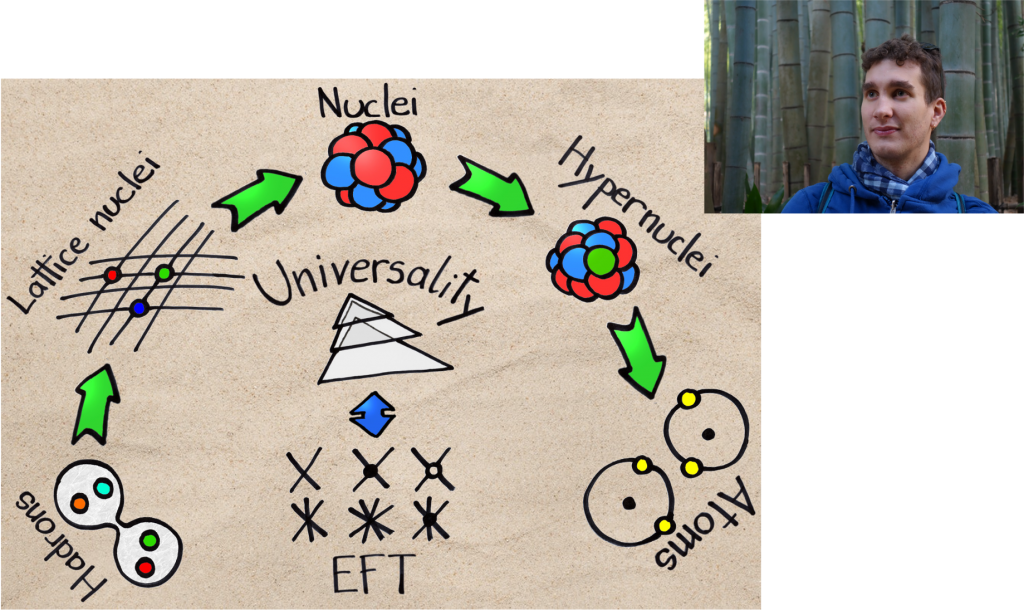
Universal systems are quantum mechanical objects that can be described similarly despite having different typical sizes, energies, and degrees of freedom. This is possible because they share identical few-body properties and show some separation of scale among observables or with the respective underlying theory. Unitarity is arguably the most common universality class which finds instances in low-energy physics and can be found in hadronic, nuclear, and atomic fields.
This interconnection between fields is important because allows for the passage of knowledge from one field to another with special benefit to the fields on which very little is experimentally known. What is the “best” theory to describe the emergent phenomena maintaining interdisciplinarity is not a simple question to be answered. However, effective field theories have proven in the years to be the most natural framework for this search since their systematic improvability and the connection to the underlying physics of the various universal systems. In this seminar, I will talk about various universal systems, especially in the unitarity universality class, with a particular focus on how they can be described, how to pass the knowledge from one field to another, and on the many-body emergent phenomena.
Monday, 04/10 (16h, CET)
Properties of neutron star crust within nuclear physics uncertainties
Guilherme GRAMS (PostDoc in IP2I-Lyon)
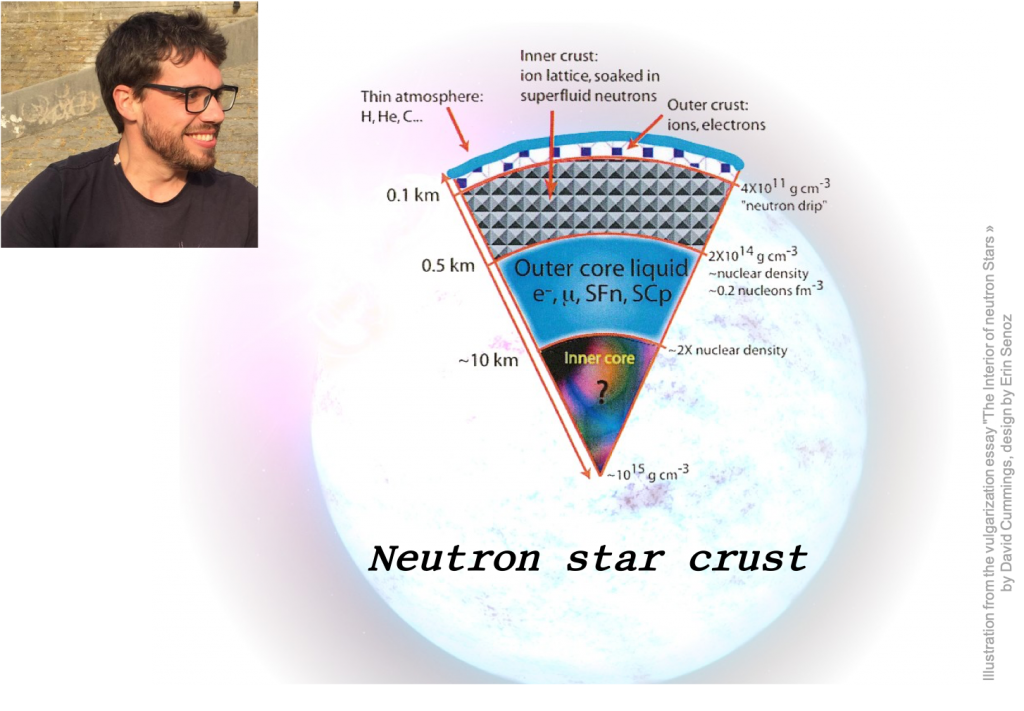
A compressible liquid drop model (CLDM) is used to correlate uncertainties associated with the properties of the neutron star (NS) crust, with uncertainties associated with Chiral Effective Field theory (χEFT) predictions for the properties of homogeneous neutron matter and nuclear matter. We also study the impact of the surface, curvature, and Coulomb energies on the crustal properties. Fits to experimental nuclear masses are employed to further constrain the CLDM, and we find that they disfavor some of the χEFT Hamiltonians. These fits also reveal how the curvature energy alters the correlation between the surface energy the bulk symmetry energy.
Properties of the NS star crust against nuclear uncertainties are then analyzed, and we show that their impact vary from one observable to another: i) the finite size models impact the crust composition (A, Z) and have negligible influence on others quantities, ii) the largest uncertainties for the asymmetries Icl and Ye, as well as the volume fraction u, are induced by the Hamiltonians alone, iii) the largest uncertainties for the matter composition in the densest regions of the crust, as well as the precise location of the crust-core transition, are related to the Hamiltonians as well as by the surface energy isospin asymmetry parameter (psurf). As a consequence, the crust moment of inertia is also largely impacted by the choice of Hamiltonian as well as by the parameter psurf . The uncertainties induced by the loss function used for the fit to finite nuclei (∆E versus ∆E/A) as well as by the in-medium nucleon mass m∗ are much smaller.
Finally, we analyze the impact of these nuclear uncertainties on the NS mass-radius relations within a unified approach and with the condition to reach 2M⊙. In the analysis of the macroscopic NS properties, the Hamiltonians are the main source of uncertainties.
Monday, 20/09 (16h, CET)
Understanding 22Na cosmic abundance by measuring lifetimes in 23Mg
Chloé FOUGÈRES (GANIL PhD Student)
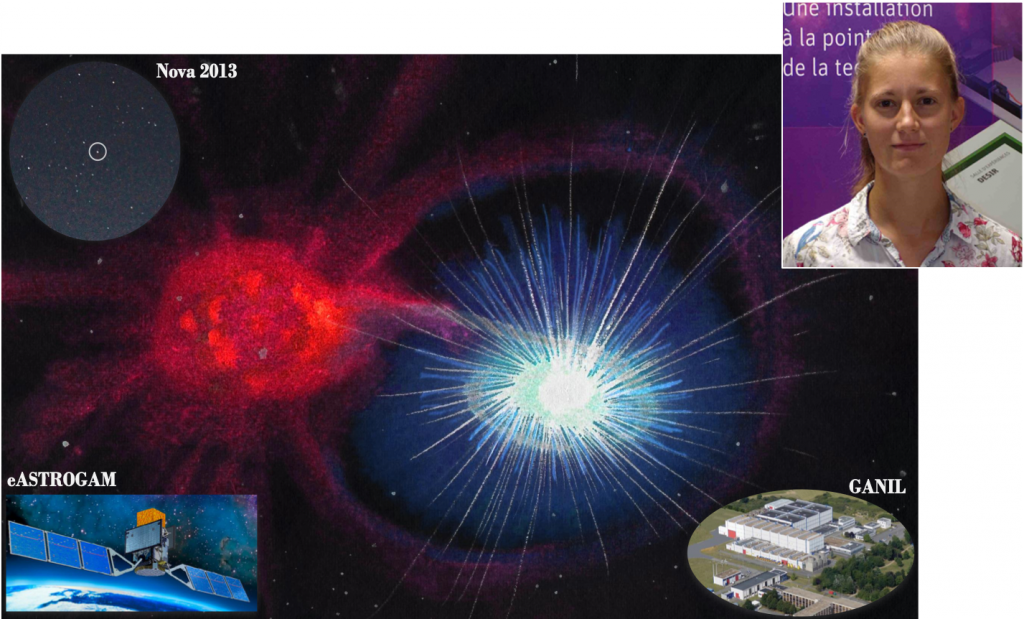
Simulations of novae explosive nucleosynthesis predict the production of the radionuclide 22Na. Its half life of 2.6 yr makes it a very interesting astronomical observable by allowing space and time correlations with the astrophysical object. This radionuclide should bring constraints on nova models. It may also help to explain abnormal 22Ne abundance observed in presolar grains and in cosmic rays. The gamma-ray line at 1.275 MeV associated with its β decay has not been observed yet by the gamma-ray space observatories [1]. New generations of gamma-ray telescopes like the european e-ASTROGAM intrusment, are expected in the coming decades. Hence accurate predicted yields of 22Na are required. Within novae thermal range, the main destruction reaction 22Na(p,γ)23Mg has been found dominated by a resonance at 0.213 MeV corresponding to 23Mg at Ex = 7.786 MeV. However the measured strengths of this resonance are in disagreement [2, 3].
An experiment was performed at the GANIL facility to measure the lifetime of the key state at Ex=7.786 MeV with an expected resolution of 1 fs. The principle of the experiment was close to the one of Ref. [4]. With a beam energy of 4.6 MeV/u, the reaction 3He(24Mg,α)23Mg∗ populated the state of interest. This reaction was tagged thanks to particle detectors (spectrometer VAMOS++, silicon detector SPIDER) and gamma tracking spectrometer AGATA. The state of interest decayed either by gamma deexcitation or proton emission. The expected time resolution of 1 fs was made possible with AGATA high space and energy resolutions. Several Doppler based methods were used to analyse the lineshape of gamma peaks. SPIDER detector gave information about the proton branching ratio.
The analysis procedures and preliminary results will be presented. Emitted light particles were identified within SPIDER data and Doppler shifted gamma rays from 23Mg excited states were measured with AGATA. Gamma spectra are improved by imposing a coincidence with 4He measured with VAMOS. It ensures to suppress feeding from higher states. A new method based on Doppler correction leads to estimate the velocity of the gamma emitting 23Mg ions and lifetimes of 23Mg excited states. Proton decays from unbound levels in 23Mg are also identified, leading to an upper value for the branching ratio of interest. With an higher precision on the lifetime at Ex = 7.786 MeV, a new value of 22Na(p,γ)23Mg resonance strength ωγ is extracted by using also the most accurate measurement in BRp [5]. The contribution of this new resonance strength to the thermonuclear 22Na(p,γ)23Mg rate is calculated and compared with the latest results [2]. Using the astrophysical code MESA [6] on nova bursts, the impact of the new rate on the predicted 22Na production will be discussed.
References
[1] R. Diehl, Astro. Rev. 9:3,1-54 (2013).
[2] A.L. Sallaska et al., Phys. Rev. Let. 105, 152501 (2010).
[3] F. Stegmuller et al., Nuc. Phy. A 601, 168-180 (1996).
[4] O.S. Kirsebom et al., Phys. Rev. C 93, 025802 (2016).
[5] M. Friedman et al., Phys. Rev. C 101, 052802(R) (2020).
[6] B. Paxton et al., APJS 208, 4 (2013).
